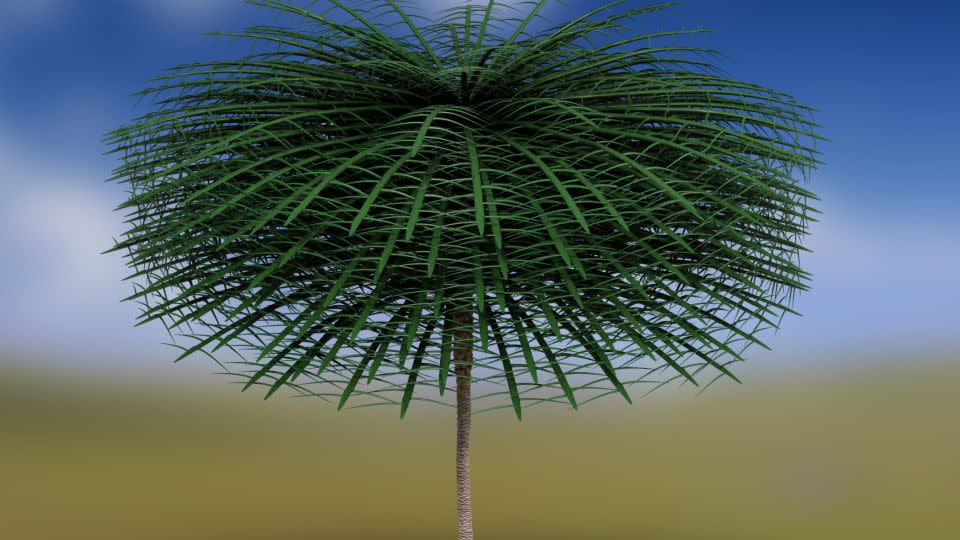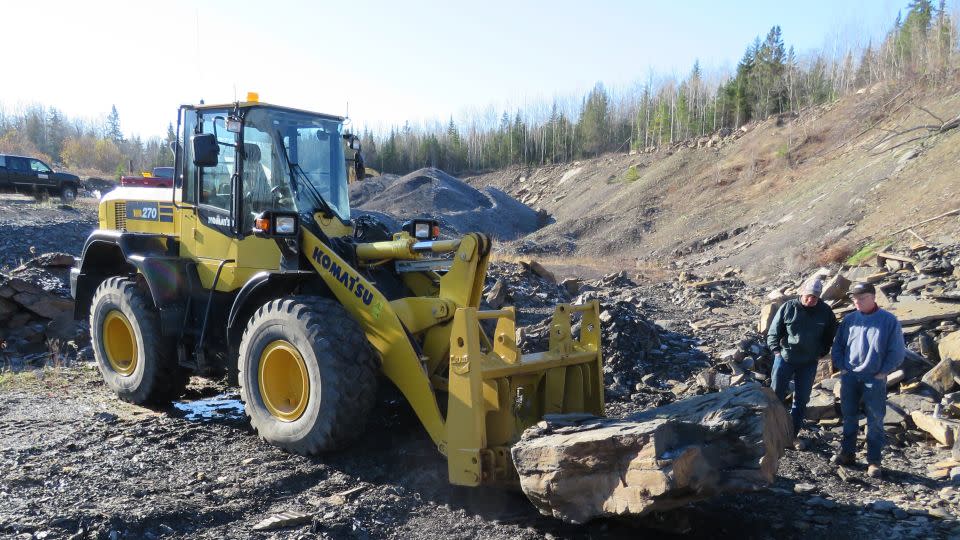Sign up for CNN’s Wonder Theory science newsletter. Explore the universe with news about fascinating discoveries, scientific developments and more.
Trees are believed to have originated hundreds of millions of years ago. Since then, evidence of these ancient plant guardians has been scarce.
Now, a new discovery of unique 3D tree fossils has opened a window into what the world looked like when the planet’s early forests began to develop, expanding our understanding of the architecture of trees throughout Earth’s history.
Five tree fossils that were buried alive by an earthquake 350 million years ago have been found in a quarry in the Canadian province of New Brunswick, according to a study published Friday in the journal Current Biology. The authors say that these new and unusual fossil trees not only have a surprising shape reminiscent of an illustration by Dr. Seuss, but also reveal clues about a period of life on Earth about which we know little.
“They are time capsules,” says Robert Gastaldo, a paleontologist and sedimentologist who led the study, “literally little windows into deep time landscapes and ecosystems.”
Co-authors Olivia King and Matthew Stimson unearthed the first of the ancient trees in 2017 during fieldwork at a New Brunswick quarry. One of the specimens they discovered is among a handful of cases in the entire plant fossil record—which spans more than 400 million years—in which a tree’s branches and petals are still attached to the trunk.
According to Gastaldo, few tree fossils have been found dating back to Earth’s earliest forests. Their discovery helps fill in some missing pieces of an incomplete fossil record.
“There are only five or six trees that we can document, at least in the Paleozoic, that have been preserved with the crown intact,” says Gastaldo, a professor of geology at Colby College in Waterville, Maine.
Most ancient tree species are relatively small, he noted, and are often discovered in the form of a fossilized trunk with a stump or root system attached. When his colleagues found a preserved tree that could have been as tall as 4.5 meters in its maturity with a crown 5.5 meters in diameter, the paleontologist was “stunned.”

Ancient earthquake burial
The researchers unearthed the first fossil tree about seven years ago, but it took a few more years before four more specimens of the same plant were found close together. The newly identified species, called ‘Sanfordiacaulis’, was named in honor of Laurie Sanford, the owner of the quarry where the trees were excavated.
According to the study, the shapes of these previously unknown, 350 million year old plants look somewhat like a modern fern or palm, despite the fact that these tree species only appeared 300 million years later. But while the tops of ferns or palms as we know them have few leaves, the most complete specimen from the newly discovered fossils has more than 250 leaves around the trunk, with each partially preserved leaf stretching about 1.7 meters.
That fossil is encased in a sandstone boulder and is about the size of a small car, said Stimson, assistant curator of geology and paleontology at the New Brunswick Museum.
The group of trees’ unique fossil record is likely due to a “catastrophic” earthquake-induced landslide that occurred in an ancient rift lake, he said.
“These trees were still alive when the earthquake happened. They were buried very quickly, very soon after, at the bottom of the lake, and then the lake went back to normal,” Stimson said.
Finding complete fossil trees is rare and much less common than finding a complete dinosaur, said Peter Wilf, a professor of geosciences and paleobotanist at Pennsylvania State University, who was not involved in the study. Wilf noted via email that the “unusual” new fossil tree was a remnant from a time period when there are almost no tree fossils.
“The new fossils are a milestone in our understanding of how early forest structure evolved, ultimately leading to the complex rainforest architectures that support most of Earth’s living biodiversity,” Wilf added.
‘Very Dr. Seuss’
To King, a research associate at the New Brunswick Museum who found the group of fossils, the Sanfordiacaulis would have looked like something straight out of Dr. Seuss was picked.
“You know, in ‘The Lorax’ the trees have big pom-poms at the top and narrow trunks? These probably have a similar structure. You have a huge crown at the top, and then it narrows and paper into this very small trunk,” King said. ‘It’s a tree that looks all over Dr. Seuss looks. It’s a weird and wonderful idea of what this thing could look like.
But the Sanfordiacaulis’ rule was short-lived, the researchers said. “We won’t see this architecture of plants again,” Stimson told CNN. He noted that it grew in the early Carboniferous period, a period near the end of the Paleozoic Era, when plants and animals diversified as they began to make their way from water to land.
Much of evolution is experimental, with success often measured by a species’ versatility, or its ability to adapt to many different places and conditions. The curious array of tree fossils provides evidence of a “failed experiment of science and evolution,” Stimson added. “We are now really starting to paint a picture of what life was like 350 million years ago.”


Look forward to something
Fossils like the Sanfordiacaulis are not only useful in helping people understand how life changed in the past, they can also help scientists figure out where life on our planet might go.
The existence of this particular species suggests that trees from that period began to occupy distinct ecological niches beyond those previously understood, according to the researchers behind its discovery.
Gastaldo sees this as an indication that plants – like early invertebrates – were experimenting with how they adapted to the environment. The earthquake that likely led to the trees’ fossils also provides new geological evidence of what may have been happening in Earth’s systems at the same time.
“This is really the first evidence we have of (a tree) being between what’s growing on the ground and what’s well above the ground,” Gastaldo said. “What else was there?”
For more CNN news and newsletters, create an account at CNN.com